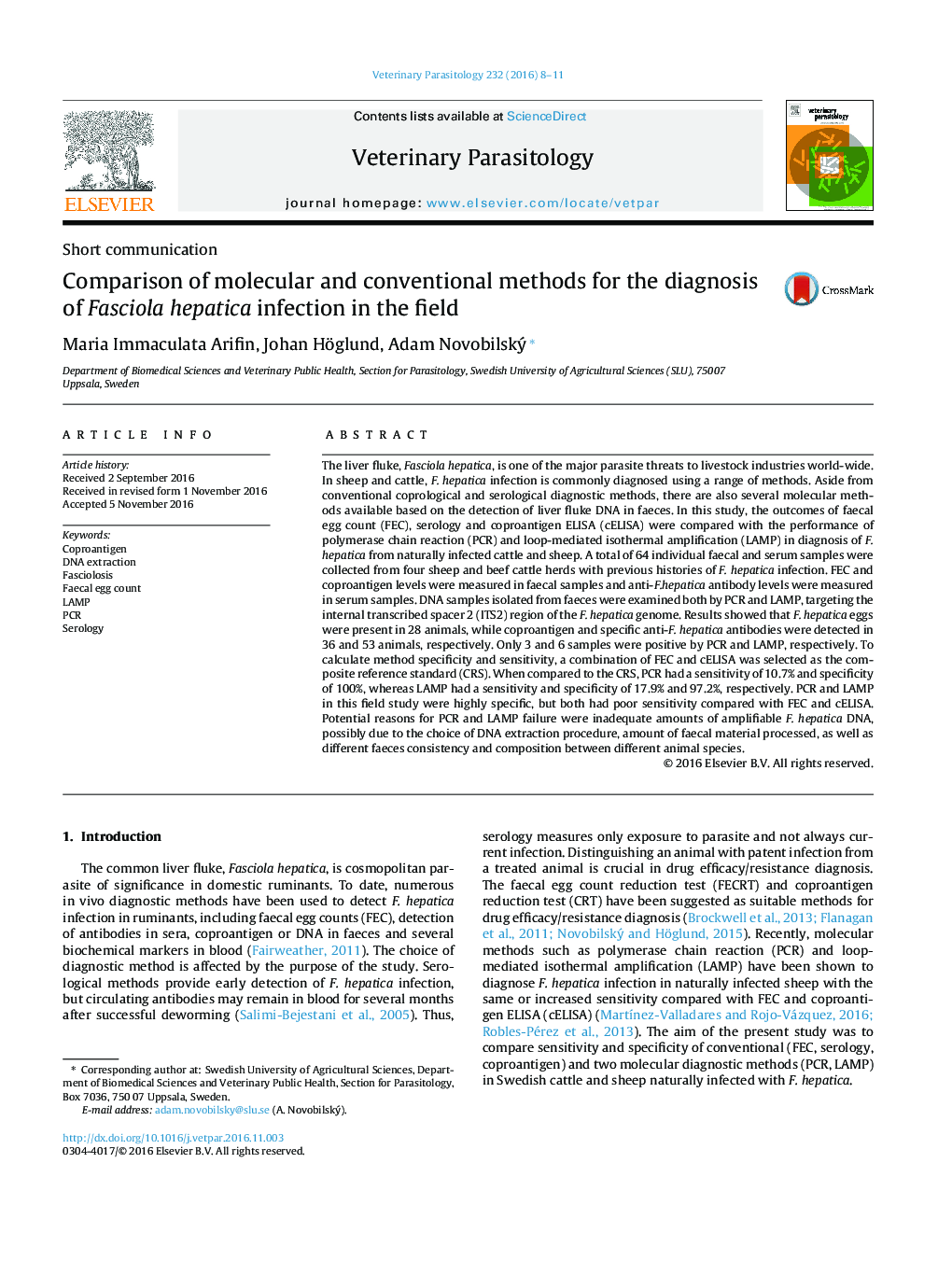| کد مقاله | کد نشریه | سال انتشار | مقاله انگلیسی | نسخه تمام متن |
|---|---|---|---|---|
| 5545913 | 1555644 | 2016 | 4 صفحه PDF | دانلود رایگان |
عنوان انگلیسی مقاله ISI
Comparison of molecular and conventional methods for the diagnosis of Fasciola hepatica infection in the field
ترجمه فارسی عنوان
مقایسه روش های مولکولی و مرسوم برای تشخیص عفونت فاسیولی هپاتیکا در این زمینه
دانلود مقاله + سفارش ترجمه
دانلود مقاله ISI انگلیسی
رایگان برای ایرانیان
کلمات کلیدی
موضوعات مرتبط
علوم زیستی و بیوفناوری
علوم کشاورزی و بیولوژیک
علوم دامی و جانورشناسی
چکیده انگلیسی
The liver fluke, Fasciola hepatica, is one of the major parasite threats to livestock industries world-wide. In sheep and cattle, F. hepatica infection is commonly diagnosed using a range of methods. Aside from conventional coprological and serological diagnostic methods, there are also several molecular methods available based on the detection of liver fluke DNA in faeces. In this study, the outcomes of faecal egg count (FEC), serology and coproantigen ELISA (cELISA) were compared with the performance of polymerase chain reaction (PCR) and loop-mediated isothermal amplification (LAMP) in diagnosis of F. hepatica from naturally infected cattle and sheep. A total of 64 individual faecal and serum samples were collected from four sheep and beef cattle herds with previous histories of F. hepatica infection. FEC and coproantigen levels were measured in faecal samples and anti-F.hepatica antibody levels were measured in serum samples. DNA samples isolated from faeces were examined both by PCR and LAMP, targeting the internal transcribed spacer 2 (ITS2) region of the F. hepatica genome. Results showed that F. hepatica eggs were present in 28 animals, while coproantigen and specific anti-F. hepatica antibodies were detected in 36 and 53 animals, respectively. Only 3 and 6 samples were positive by PCR and LAMP, respectively. To calculate method specificity and sensitivity, a combination of FEC and cELISA was selected as the composite reference standard (CRS). When compared to the CRS, PCR had a sensitivity of 10.7% and specificity of 100%, whereas LAMP had a sensitivity and specificity of 17.9% and 97.2%, respectively. PCR and LAMP in this field study were highly specific, but both had poor sensitivity compared with FEC and cELISA. Potential reasons for PCR and LAMP failure were inadequate amounts of amplifiable F. hepatica DNA, possibly due to the choice of DNA extraction procedure, amount of faecal material processed, as well as different faeces consistency and composition between different animal species.
ناشر
Database: Elsevier - ScienceDirect (ساینس دایرکت)
Journal: Veterinary Parasitology - Volume 232, 15 December 2016, Pages 8-11
Journal: Veterinary Parasitology - Volume 232, 15 December 2016, Pages 8-11
نویسندگان
Maria Immaculata Arifin, Johan Höglund, Adam Novobilský,
